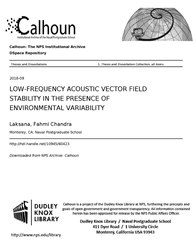File:LOW-FREQUENCY ACOUSTIC VECTOR FIELD STABILITY IN THE PRESENCE OF ENVIRONMENTAL VARIABILITY (IA lowfrequencyacou1094560423).pdf

Original file (1,275 × 1,650 pixels, file size: 2.02 MB, MIME type: application/pdf, 64 pages)
Captions
Captions
Summary[edit]
| LOW-FREQUENCY ACOUSTIC VECTOR FIELD STABILITY IN THE PRESENCE OF ENVIRONMENTAL VARIABILITY
( |
||
|---|---|---|
| Author |
Laksana, Fahmi Chandra |
|
| Title |
LOW-FREQUENCY ACOUSTIC VECTOR FIELD STABILITY IN THE PRESENCE OF ENVIRONMENTAL VARIABILITY |
|
| Publisher |
Monterey, CA; Naval Postgraduate School |
|
| Description |
The Department of Physics at the Naval Postgraduate School recently collected data from a low-frequency vector sensor system off the coast of Big Sur, California, in May 2018. During the test, signals from numerous surface craft were recorded. In this study, a numerical model was employed to estimate the vector field transmission loss at low frequency in order to estimate performance of the system during the test. In order to provide realistic ranges of values, the impact of environmental variability was examined and the primary factors affecting transmission loss were identified. The range-dependent environmental features included varying bathymetry as well as a rough pressure release surface that can predict the effects of rough surface scattering. During the field test, sound speed profile measurements were made, and surface wave buoy data was collected that provided realistic estimates of these features in the vicinity of the sensor system. Various geoacoustic bottom parameters were modeled in order to estimate the potential variability in transmission loss levels due to uncertainty in bottom type. Finally, models of merchant ship source levels were combined with the range of transmission loss predictions to develop estimates for received levels on the vector sensor system during the test. These estimates will then provide a guide during the post-processing of the data collected and may lead to improvements in source level modeling. Subjects: vector field; stability; low frequency; environmental variability |
|
| Language | English | |
| Publication date | September 2018 | |
| Current location |
IA Collections: navalpostgraduateschoollibrary; fedlink |
|
| Accession number |
lowfrequencyacou1094560423 |
|
| Source | ||
| Permission (Reusing this file) |
Copyright is reserved by the copyright owner. | |
Licensing[edit]
| Public domainPublic domainfalsefalse |
This work is in the public domain in the United States because it is a work prepared by an officer or employee of the United States Government as part of that person’s official duties under the terms of Title 17, Chapter 1, Section 105 of the US Code.
Note: This only applies to original works of the Federal Government and not to the work of any individual U.S. state, territory, commonwealth, county, municipality, or any other subdivision. This template also does not apply to postage stamp designs published by the United States Postal Service since 1978. (See § 313.6(C)(1) of Compendium of U.S. Copyright Office Practices). It also does not apply to certain US coins; see The US Mint Terms of Use.
|
 | |
| This file has been identified as being free of known restrictions under copyright law, including all related and neighboring rights. | ||
https://creativecommons.org/publicdomain/mark/1.0/PDMCreative Commons Public Domain Mark 1.0falsefalse
File history
Click on a date/time to view the file as it appeared at that time.
| Date/Time | Thumbnail | Dimensions | User | Comment | |
|---|---|---|---|---|---|
| current | 16:43, 22 July 2020 |  | 1,275 × 1,650, 64 pages (2.02 MB) | Fæ (talk | contribs) | FEDLINK - United States Federal Collection lowfrequencyacou1094560423 (User talk:Fæ/IA books#Fork8) (batch 1993-2020 #20963) |
You cannot overwrite this file.
File usage on Commons
The following page uses this file:
Metadata
This file contains additional information such as Exif metadata which may have been added by the digital camera, scanner, or software program used to create or digitize it. If the file has been modified from its original state, some details such as the timestamp may not fully reflect those of the original file. The timestamp is only as accurate as the clock in the camera, and it may be completely wrong.
| Short title | LOW-FREQUENCY ACOUSTIC VECTOR FIELD STABILITY IN THE PRESENCE OF ENVIRONMENTAL VARIABILITY |
|---|---|
| Image title | |
| Author | Laksana, Fahmi Chandra |
| Software used | Laksana, Fahmi Chandra |
| Conversion program | Adobe PDF Library 11.0 |
| Encrypted | no |
| Page size | 612 x 792 pts (letter) |
| Version of PDF format | 1.4 |

